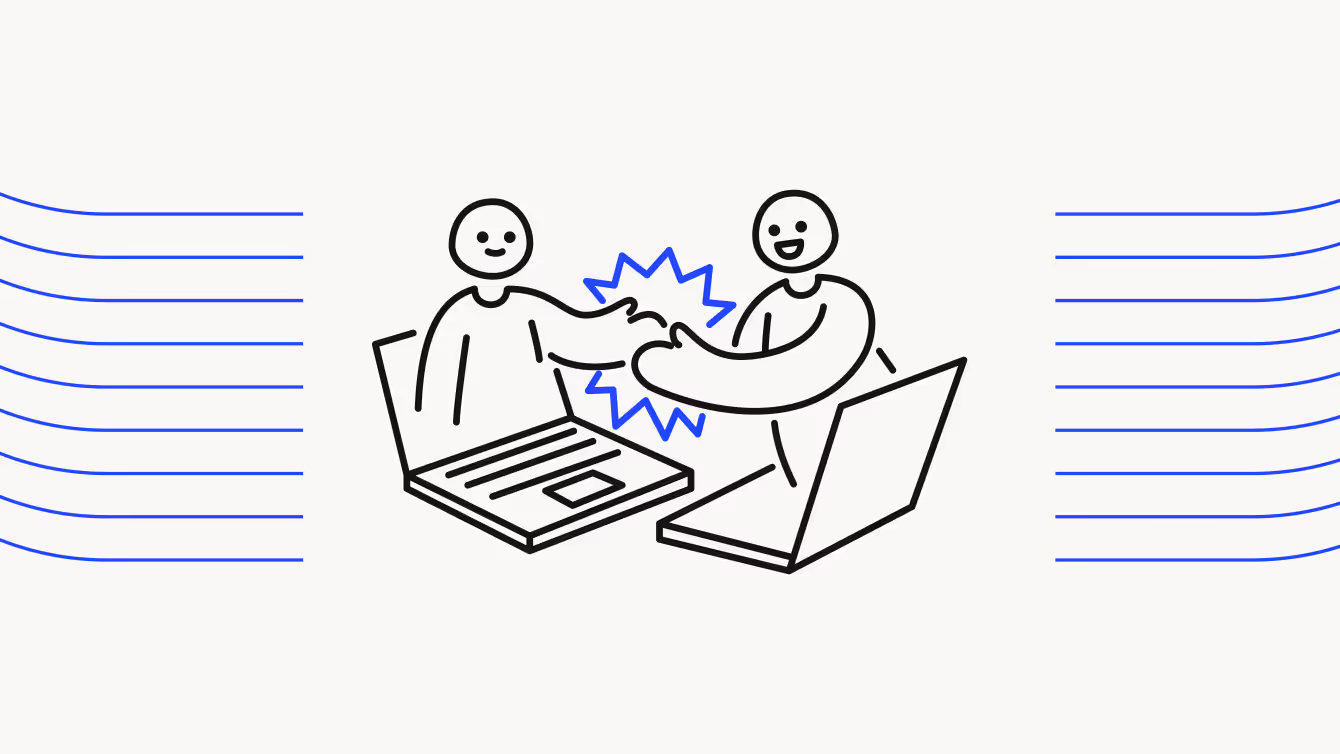Best practices for boosting employee morale

Discover Workleap Officevibe's benchmark report on 12 key employee engagement metrics

A happy workforce doesn’t just feel good. It performs better, too. When employee morale is high, people are more engaged, more productive, and more likely to stick around.
The secret? Building a workplace people actually want to be in. A place where they feel seen, supported, and motivated to do their best work. So if you’re not intentionally investing in employee morale, you’re leaving performance and potential on the table.
Here’s how to improve morale in the workplace to build a culture where people feel supported and ready to thrive.
What’s employee morale?
Employee morale is the overall level of satisfaction, motivation, and enthusiasm people feel toward their work. When morale is high, employees show up engaged, productive, and committed — not because they have to, but because they want to.
But achieving great morale is easier said than done. According to Gallup’s State of the Global Workplace report, only 33% of today’s employees say they’re thriving. Engagement levels are slipping year over year, and these are the biggest reasons why.
Burnout
Burnout is a state of mental exhaustion caused by prolonged stress. Overworked, tired employees often lack the energy to perform at their best. When burnout sets in, people struggle to take initiative because they’ve lost their sense of connection and urgency.
Poor leadership
Leaders play a vital role in shaping a positive work environment. When they communicate clearly, celebrate wins, and encourage autonomy, employees gain the confidence to do their best work. But when leadership falls short, people are left feeling confused, frustrated, and undervalued.
Lack of growth opportunities
Personal and professional development is essential to employee morale. Whether through learning programs or mentoring, many employees want to feel like they’re moving forward. Skilled, supported workers elevate those around them and strengthen the entire team. Without growth opportunities, workplaces risk feeling stagnant and uninspiring.
Micromanagement
Micromanagement chips away at employee confidence and motivation. When someone else dictates every step of your workflow, it’s hard to feel trusted or respected. To feel proud of their work and celebrate progress, people need autonomy and space to make decisions.
Poor communication
Leaders who fail to clearly explain tasks leave teams pulling in different directions. Employees who don’t raise blockers disrupt workflows. And teams that skip cross-functional collaboration slow down progress and create silos. These forms of weak communication cause delays and confusion, ultimately resulting in a misaligned team.
Toxic company culture
Behaviors like aggression, favoritism, or dishonesty create a company culture no one wants to be part of. At best, that culture makes work unpleasant. At worst, it creates fear and psychological harm. Employees are quick to leave when they sense a toxic environment. And they’re hard to replace once they’re gone.
Unrealistic expectations
When goals are unclear or deadlines are impossible to meet, frustration is the inevitable result. Employees feel set up to fail, and their confidence takes a hit. If leaders respond with criticism instead of support when goals get missed, morale drops even further.
Lack of appreciation
Recognition matters. When hard work goes unnoticed, employees start to question their impact and value. Over time, feeling undervalued leads to lower morale, disengagement, and weaker performance across the board.
8 ideas to increase employee morale
Low morale has real consequences. It drags down productivity, fuels turnover, and can even damage your organization’s reputation.
The good news? You can turn things around. Here are eight ways to boost morale at work to support your your employees’ motivation and well-being.
1. Gather employee feedback
Frequent, thoughtful feedback is the foundation of any morale strategy. It not only uncovers blind spots and sources of frustration but also signals to employees that their experiences matter. Use tools like engagement surveys and regular manager one-on-ones to keep a pulse on how people are feeling. The more consistently you listen, the earlier you can intervene, building trust along the way.
2. Celebrate achievements
Recognition is one of the most powerful (and most overlooked) drivers of morale. When people feel seen for their contributions, motivation rises across the board. You can encourage a culture of appreciation by normalizing shoutouts, both in team meetings and through peer-to-peer recognition. Even a quick, thoughtful note can leave a lasting impact.
3. Support health and wellness
When employees aren’t physically or mentally well, performance and morale suffer. Promote a healthy work-life balance by encouraging time off, setting clear boundaries, and offering flexibility where you can. And instead of treating benefits like health, dental, and vision coverage as checkboxes, think of them as strategic investments that fuel long-term productivity and retention.
4. Live your company culture and values
Don’t just hang your mission and values on a poster in the breakroom and call it a day. Let them shape how people work, and revisit them regularly to find ways to bring them to life in team workflows. If communication is a core value, for example, you might invest in active listening training for managers. If growth is central, clear paths for professional development might be the top thing you should focus on.
5. Communicate effectively
Good workplace communication requires both intention and the right tools. Use a combination of asynchronous messaging, structured check-ins, and shared project visibility to foster open dialogue across all levels of the organization. Workleap Officevibe makes it easy, combining pulse surveys, anonymous feedback, and peer-to-peer “Good Vibes” in one platform. Officevibe keeps communication flowing in every direction, making sure no one feels unheard or out of the loop.
6. Encourage connection and team-building
A sense of belonging is built through shared experiences. Morale-boosting activities like team-building exercises, professional development sessions, or casual social events help employees feel part of something bigger. Give your team the time and tools to connect in the ways that work for them, whether it’s an off-site outing or a virtual coffee chat for remote teams.
7. Train your leaders
Equip your managers with the skills to communicate effectively, support autonomy, and guide growth. You can do this by offering structured training, setting leadership performance goals, and creating mentorship opportunities for new leaders. Just as importantly, gather regular feedback from employees to assess leadership impact and identify where support is still needed.
8. Create a diverse and inclusive workplace
Prioritize diversity across hiring, onboarding, and everyday team interactions. Train HR and managers to recognize bias, and ensure onboarding includes inclusive practices like asking new hires for their preferred pronouns. Be thoughtful with the way you celebrate cultural holidays, inviting employees to share their traditions in ways that feel authentic. When people feel respected and represented, morale gets a meaningful lift.
How to measure employee morale
The best way to understand morale is to ask. These tools and tactics can help you track how people are really feeling:
- Employee surveys: Anonymous surveys reveal how employees really feel about things like work-life balance, leadership, and job satisfaction. Use tools like pulse surveys or eNPS to catch early trends.
- Grievance reporting: A clear, trusted process encourages employees to report serious concerns like harassment or pay issues. Make sure it’s well-communicated and easy to access.
- Suggestion boxes: Whether physical or virtual, suggestion boxes offer a simple way for employees to share ideas or concerns. Private options tend to generate more honest input.
- Exit interviews: Employees often share more candid feedback when they’re on their way out. Use these conversations to identify patterns and improve the employee experience.
Signs of high employee morale
Once you’ve put morale-boosting efforts in place, watch for these signs to confirm they’re working:
- Reduced absenteeism: People who enjoy work find fewer excuses to call in sick or skip a day.
- Improved productivity: Engaged employees cruise through tasks instead of procrastinating.
- Lower turnover: A positive work culture makes employees want to stick around.
- Strong performance: Motivated teams deliver higher-quality results.
- Great survey results: Morale shows up in the data. Watch for upward trends in engagement feedback.
Improve morale with Workleap
Boosting the morale of employees takes more than one-off efforts. It requires ongoing visibility, consistent communication, and a carefully crafted culture of recognition. That’s where Workleap Officevibe comes in.
With easy-to-use features like pulse surveys, anonymous feedback, and peer-to-peer shoutouts, Officevibe helps managers stay connected and act with confidence. The result? Teams feel heard, supported, and motivated to do their best work.
Try Workleap Officevibe for free to start building a workplace your people are proud to be part of.
FAQs
How often should you assess employee morale?
Aim to formally assess morale at least once per quarter. But remember that morale isn’t static. It’s important to collect constant feedback through tools like pulse surveys, suggestion boxes, and quick manager check-ins.
What’s a good question for assessing employee morale?
Morale drivers vary by person, so include a mix of broad and company-specific questions. For example, ask how your new hybrid policy is landing, or how employees would describe the company culture. Open-ended questions work well when paired with space for constructive feedback.
What questions shouldn’t you ask on employee surveys?
Avoid leading questions, which can bias responses and limit the accuracy of your data. The goal is to uncover real insights, not steer employees toward what you want to hear. Skip anything too personal or invasive, and never ask employees to critique their peers by name. For serious concerns, your HR team should have a clear, confidential reporting process in place.
Give HR and managers the clarity, confidence, and connection to lead better every day.


%20(1).avif)


.avif)
.avif)








